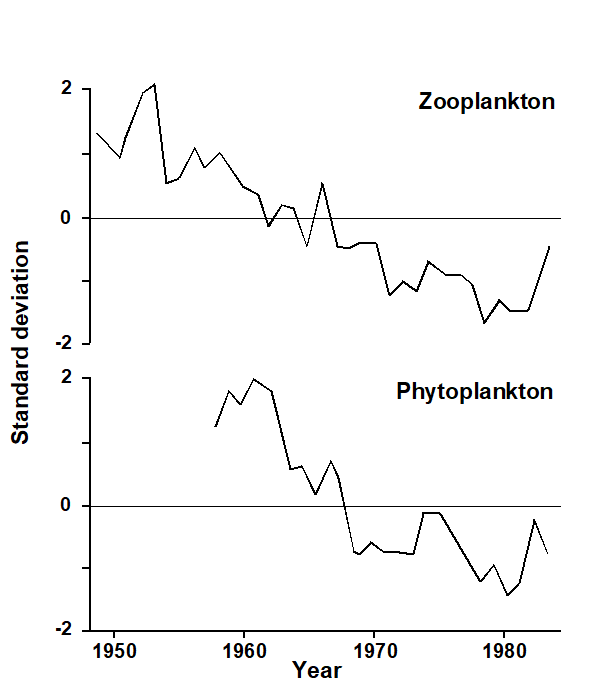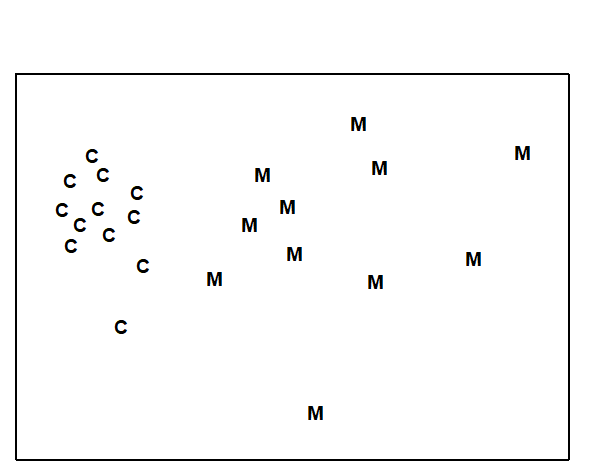13.2 Plankton and fish
Plankton
The advantages of plankton are that:
a) Long tows over relatively large distances result in community samples which reflect integrated ecological conditions over large areas. They are therefore useful in monitoring more global changes.
b) Identification of macro-planktonic organisms is moderately easy, because of the ready availability of appropriate literature.
The disadvantage of plankton is that, because the water masses in which they are suspended are continually mobile, they are not useful for monitoring the local effects of a particular pollutant source.
Example: Continuous Plankton Recorder
Plankton samples have been collected from ‘ships of opportunity’ plying their usual commercial routes across the NE Atlantic since the late 1940s (e.g. Colebrook (1986) ) and continue today, their historical continuity (through the Sir Alister Hardy Foundation for Ocean Science, Plymouth, UK) giving the survey ever greater importance with respect to climate change monitoring. The CPR plankton recorders collect samples through a small aperture, and these are trapped on a continuously winding roll of silk so that each section of silk contains an integrated sample from a relatively large area. This has enabled long term trends in plankton abundance to be assessed; e.g. Colebrook (1986) describes a gradual decline in both zooplankton and phytoplankton since the early 1950s, with an upturn in the 1980s (Fig. 13.1).
Fig. 13.1. Continuous Plankton Recorder Survey of the NE Atlantic {p}. First principal components for zooplankton and phytoplankton over the first 35 years of the survey (from
Colebrook (1986)
). Graphs scaled to zero mean and unit variance.
Fish
The advantages of fish are that:
a) Because of their mobility they are again more useful for studying general rather than local effects, but some demersal fish communities may show site fidelity, such as the coral-reef fish in the example below.
b) The taxonomy of fish is relatively easy, in all parts of the world.
c) Fish are of immediate commercial and public interest, and so studies of fish communities are more directly related to the needs of environmental managers than, for example, the meiobenthos (despite the fact, of course, that the latter are vitally important to the early life-stages of fish!).
The disadvantages of fish are that:
a) Strictly quantitative sampling which is equally representative of all the species in the community is difficult. The overall catching efficiency of nets, traps etc. is often unknown, as are the differing abilities of species to evade capture or their susceptibility to be attracted to traps. Visual census methods are also not free from bias, since some species will be more conspicuous in colouration or behaviour than other dull secretive species.
b) Uncertainty about site fidelity is usually, but not always, a problem.
Example: Maldives coral reef-fish
For a study in the Maldive islands, Dawson-Shepherd, Warwick, Clarke et al. (1992) used visual census methods to compare reef-fish assemblages at 23 coral reef-flat sites, 11 of which had been subjected to coral mining for the construction industry and 12 were non-mined controls. The MDS (Fig. 13.2) clearly distinguished mined from non-mined sites.
Fig. 13.2. Maldive Islands, coral-reef fish {M}. MDS ordination of fish species abundance data from mined (M) and control (C) reef-flats (stress = 0.08).


